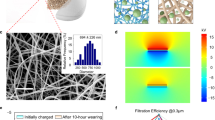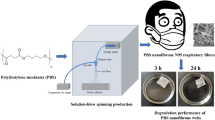Abstract
Protection for the respiratory system has become a need of the day due to increased air pollution. Different nonwoven filter media have been incorporated into filtering facepiece respirators (FFRs). However, the performance of these systems could be improved further by the addition of finer nanowebs. The effect of the addition of intermediate media (nanowebs) on the comfort of FFRs also needs to be studied, as comfort can affect the performance of wearer. In this study, electrospun polymeric nanowebs were incorporated between layers of commercially available nonwoven fabrics to improve its filtration performance. The effect of the addition of polymeric webs between the layers of nonwoven filter media on the comfort properties was also studied. It was concluded that the addition of nanowebs remarkably improved the filtration capability of filter media. Also, it was found to have mixed impact on comfort properties of the resultant composite filter media; air permeability was reduced from 58 to 50 mm/s, while the filtration efficiency was improved along with thermal and water vapor permeability. Thermal conductivity was increased from 30.5 to 39 [(W/cm °C) × 104]. Water vapor permeability increased from 1.70 to 2.04 [(g/s mm2) × 108].









Similar content being viewed by others
References
Kjellstrom T, Lodh M, McMichael T, Ranmuthugala G, Shrestha R, Kingsland S (2006) Air and water pollution: burden and strategies for control. The International Bank for Reconstruction and Development/The World Bank, Washington DC
Zarocostas J (2006) Air pollution is a major threat to health says WHO. BMJ 333(7571):722
Dickenson TC (1997) Filters and filtration handbook. Elsevier, Amsterdam
Hutten IM (2007) Handbook of non-woven filter media. Elsevier, Amsterdam
Spurný K (1998) Advances in aerosol filtration. Lewis Publishers, Boca Raton
Qin X-H, Wang S-Y (2006) Filtration properties of electrospinning nanofibers. J Appl Polym Sci 102(2):1285–1290
Ryu YJ, Kim HY, Lee KH, Park HC, Lee DR (2003) Transport properties of electrospun nylon 6 nonwoven mats. Eur Polym J 39(9):1883–1889
Podgórski A, Bałazy A, Gradoń L (2006) Application of nanofibers to improve the filtration efficiency of the most penetrating aerosol particles in fibrous filters. Chem Eng Sci 61(20):6804–6815
Min K, Kim S, Kim S (2018) Silk protein nanofibers for highly efficient, eco-friendly, optically translucent, and multifunctional air filters. Sci Rep 8(1):9598
Zhang R et al (2016) Nanofiber air filters with high-temperature stability for efficient PM 2.5 removal from the pollution sources. Nano Lett 16(6):3642–3649
Gopal R et al (2007) Electrospun nanofibrous polysulfone membranes as pre-filters: particulate removal. J Memb Sci 289(1–2):210–219
Abid S, Hussain T, Raza ZA, Nazir A (2019) Current applications of electrospun polymeric nanofibers in cancer therapy. Mater Sci Eng, C 97:966–977
Abid S et al (2019) Enhanced antibacterial activity of PEO-chitosan nanofibers with potential application in burn infection management. Int J Biol Macromol 135:1222–1236
Abid S, Hussain T, Nazir A, Zahir A, Khenoussi N (2018) Acetaminophen loaded nanofibers as a potential contact layer for pain management in Burn wounds. Mater. Res. Express 5(8):085017
Abid S, Hussain T, Nazir A, Khenoussi N, Zahir A, Riaz S (2018) Development of nanofibers based neuropathic patch loaded with lidocaine to deal with nerve pain in burn patients. IOP Conf Ser Mater Sci Eng 414(1):012019
Abid S, Hussain T, Nazir A, Zahir A, Khenoussi N (2019) A novel double-layered polymeric nanofiber-based dressing with controlled drug delivery for pain management in burn wounds. Polym Bull 76(12):6387–6411
Wang Y, Li W, Xia Y, Jiao X, Chen D (2014) Electrospun flexible self-standing γ-alumina fibrous membranes and their potential as high-efficiency fine particulate filtration media. J Mater Chem A 2(36):15124–15131
Dotti F, Varesano A, Montarsolo A, Aluigi A, Tonin C, Mazzuchetti G (2007) Electrospun porous mats for high efficiency filtration. J Ind Text 37(2):151–162
Li L, Frey MW, Green TB (2006) Modification of air filter media with nylon-6 nanofibers. J Eng Fibers Fabr. 1:155892500600100101
Barhate RS, Loong CK, Ramakrishna S (2006) Preparation and characterization of nanofibrous filtering media. J Memb Sci 283(1–2):209–218
Heikkilä P, Taipale A, Lehtimäki M, Harlin A (2008) Electrospinning of polyamides with different chain compositions for filtration application. Polym Eng Sci 48(6):1168–1176
Faccini M, Amantia D, Vázquez-Campos S, Vaquero C, de Ipiña JML, Aubouy L (2011) Nanofiber-based filters as novel barrier systems for nanomaterial exposure scenarios. J Phys: Conf Ser 304(1):012067
Kuo Y-Y, Bruno FC, Wang J (2014) Filtration performance against nanoparticles by electrospun nylon-6 media containing ultrathin nanofibers. Aerosol Sci Technol 48(12):1332–1344
Kuo C-N, Chen H-F, Lin J-N, Wan B-Z (2007) Nano-gold supported on TiO2 coated glass-fiber for removing toxic CO gas from air. Catal Today 122(3–4):270–276
Marsano E, Francis L, Giunco F (2010) Polyamide 6 nanofibrous nonwovens via electrospinning. J Appl Polym Sci 117(3):1754–1765
Demir B, Cerkez I, Worley SD, Broughton RM, Huang T-S (2015) N-Halamine-modified antimicrobial polypropylene nonwoven fabrics for use against airborne bacteria. ACS Appl Mater Interfaces 7(3):1752–1757
Laird IS, Goldsmith R, Pack RJ, Vitalis A (2002) The effect on heart rate and facial skin temperature of wearing respiratory protection at work. Ann Occup Hyg 46(2):143–148
Smith JD, MacDougall CC, Johnstone J, Copes RA, Schwartz B, Garber GE (2016) Effectiveness of N95 respirators versus surgical masks in protecting health care workers from acute respiratory infection: a systematic review and meta-analysis. CMAJ 188(8):567–574
Shen H et al (2019) Analysis of heat transfer characteristics in textiles and factors affecting thermal properties by modeling. Text Res J 89(21–22):4681–4690
Chen J, Yu W (2011) Structure designing and property investigation of flexible multilayer thermal insulation materials. Res J Text Appar 15:21–27
Han HR, Park Y, Yun C, Park CH (2018) Heat transfer characteristics of aluminum sputtered fabrics. J Eng Fiber Fabr 13(3):155892501801300
Wei J, Xu S, Liu H, Zheng L, Qian Y (2015) Simplified model for predicting fabric thermal resistance according to its microstructural parameters. Fibers Text East Eur 23(112):57–60
Akshat TM, Misra S, Gudiyawar MY, Salacova J, Petru M (2019) Effect of electrospun nanofiber deposition on thermo-physiology of functional clothing. Fibers Polym 20(5):991–1002
Zhou SS, Lukula S, Chiossone C, Nims RW, Suchmann DB, Ijaz MK (2018) Assessment of a respiratory face mask for capturing air pollutants and pathogens including human influenza and rhinoviruses. J Thorac Dis 10(3):2059–2069
Liu YP, Deng Y, Jiang ZX (2012) Effect of nanofiber diameter on filtration efficiency. Adv Mater Res 560–561:737–741
Koch M, Krammer G (2008) The permeability distribution (PD) method for filter media characterization. Aerosol Sci Technol 42(6):433–444
Akduman C, Kumbasar EPA (2017) Electrospun polyurethane nanofibers. In: Aspects of polyurethanes. IntechOpen. https://doi.org/10.5772/intechopen.69937
Kizildag N, Ucar N (2016) Electrospinning functional polyacrylonitrile nanofibers with polyaniline, carbon nanotubes, and silver nitrate as additives. In: Electrospinning—material, techniques, and biomedical applications. InTech. https://doi.org/10.5772/65472
Sinha MK, Das BR (2018) Chitosan nanofibrous materials for chemical and biological protection. J Text Fibrous Mater 1:251522111878837
Acknowledgments
Authors acknowledge LPMT-France for testing.
Funding
The project was not funded.
Author information
Authors and Affiliations
Corresponding author
Ethics declarations
Conflict of interest
The authors declare that they have no conflict of interest.
Additional information
Publisher's Note
Springer Nature remains neutral with regard to jurisdictional claims in published maps and institutional affiliations.
Rights and permissions
About this article
Cite this article
Nazir, A., Khenoussi, N., Hussain, T. et al. Enhanced filtration and comfort properties of nonwoven filtering facepiece respirator by the incorporation of polymeric nanoweb. Polym. Bull. 77, 5155–5173 (2020). https://doi.org/10.1007/s00289-019-03009-1
Received:
Revised:
Accepted:
Published:
Issue Date:
DOI: https://doi.org/10.1007/s00289-019-03009-1




